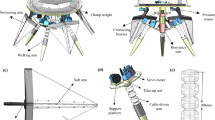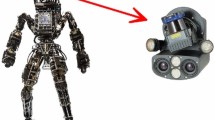Abstract
Stick insects (Cuniculina impigra) possessing only one foreleg with restrained coxa performed searching movements. A force transducer was introduced as an obstacle into the plane of movement of femur or tibia. Depending on where it was introduced and whether it was touched for the first time during an upward or a downward movement, different kinds of behaviour of the leg were released. For these different movements, the forces applied to the obstacle and the electrical activity of the depressor, levator, retractor and protractor muscles are described. In addition the alterations occurring after ablation of several sense organs including the trochanteral campaniform sensilla are mentioned. The described movements were similar to the corresponding behaviours during walking at the end of swing phase and the beginning of stance phase. Therefore there is some probability that results obtained by this experimental paradigm can also be applied to the swing-stance transition.
Similar content being viewed by others
References
Andersson O, Forssberg H, Grillner S, Wallén P (1981) Peripheral feedback mechanisms acting on the central pattern generators for locomotion in fish and cat. Can J Physiol Pharmacol 59:713–726
Bässler U (1973) Zur Steuerung aktiver Bewegungen des Femur-Tibia Gelenkes der Stabheuschrecke Carausius morosus. Kybernetik 13:38–53
Bässler U (1977) Sense organs in the femur of the stick insect and their relevance to the control of position of the femur-tibia-joint. J Comp Physiol 121:99–113
Bässler U (1983) Neural basis of elementary behavior in stick insects. Springer, Berlin Heidelberg New York
Bässler U (1987) Timing and shaping influences on the motor output for walking in stick insects. Biol Cybern 55:397–401
Bässler U (1988) Functional principles of pattern generation for walking movements of stick insect forelegs: the role of the femoral chordotonal organ afferences. J Exp Biol 136:125–147
Cruse H (1976) The function of the legs in the free walking stick insect, Carausius morosus. J Comp Physiol 112:235–262
Cruse H (1980) A quantitative model of walking incorporating central and peripheral influences. I. The control of the individual leg. Biol Cybern 37:131–136
Cruse H (1985) Which parameters control the leg movement of a walking insect. II. The start of the swing phase. J Exp Biol 116:357–362
Cruse H, Epstein S (1982) Peripheral influences on the movement of the legs in a walking insect, Carausius morosus. J Exp Biol 101:161–170
Cruse H, Saxler G (1980) Oscillations of force in the standing legs of a walking insect (Carausius morosus). Biol Cybern 36:159–163
Dean J (1984) Control of leg protraction in the stick insect: a targeted movement showing compensation for externally applied forces. J Comp Physiol A 155:771–781
Dean J, Wendler G (1982) Stick insects walking on a wheel: perturbations induced by obstruction of leg protraction. J Comp Physiol 148:195–207
Delcomyn F (1987) Motor activity during searching and walking movements of cockroach legs. J Exp Biol 133:111–120
Foth E, Graham D (1983) Influence of loading parallel to the body axis on the walking coordination of an insect. I. Ipsilateral effects. Biol Cybern 47:17–23
Godden D, Graham D (1984) A preparation of the stick insect Carausius morosus for recording intracellularly from identified neurones during walking. Physiol Entomol 9:275–286
Graham D, Bässler U (1981) Effects of afference sign reversal on motor activity in walking stick insects (Carausius morosus). J Exp Biol 91:179–193
Graham D, Wendler G (1981a) The reflex behaviour and innervation of the tergocoxal retractor muscles of the stick insect (Carausius morosus). J Comp Physiol 143:81–91
Graham D, Wendler G (1981b) Motor output to the protractor and retractor coxae muscles of Carausius morosus during walking on a treadwheel. Physiol Entomol 6:161–174
Grillner S (1981) Motor control. In: Brooks, UB (ed) Handbook of physiology. Sect. 1: The nervous system, vol 2. Williams & Wilkins, Baltimore, pp 1179–1236
Hofmann T, Bässler U (1982) Anatomy and physiology of trochanteral campaniform sensilla in the stick insect Cuniculina impigra. Physiol Entomol 7:413–426
Karg G, Breutel G, Bässler U (1991) Sensory influences on the coordination of two leg joints during searching movements of stick insects. Biol Cybern 64:329–335
Nothof U, Bässler U (1990) The network producing the “active reaction” of stick insects is a functional element of different pattern generating systems. Biol Cybern 62:453–462
Pearson KG (1987) Central pattern generation: a concept under scrutiny. In: McLennan H, Ledsawe JR, McIntosh CHS, Jones DR (eds) Advances in physiological research. Plenum Press, New York
Schmitz J (1986) The depressor trochanteris motoneurones and their role in the coxa-trochanteral feedback loop in the stick insect Carausius morosus. Biol Cybern 55:25–34
Storrer J, Bässler U, Mayer S (1986) Motoneurone im Meso- und Metathorakalganglion der Stabheuschrecke Carausius morosus. Zool Jb Physiol 90:359–374
Weiland G, Bässler U, Brunner M (1986) A biological feedback control system with electronic input: the artificially closed femurtibia control system of stick insects. J Exp Biol 120:369–385
Wendler G (1972) Körperhaltung bei der Stabheuschrecke: Ihre Beziehung zur Schwereorientierung und Mechanismen ihrer Regelung. Verh Dt Zool Ges 65:214–219
Author information
Authors and Affiliations
Rights and permissions
About this article
Cite this article
Bässler, U., Rohrbacher, J., Karg, G. et al. Interruption of searching movements of partly restrained front legs of stick insects, a model situation for the start of a stance phase?. Biol. Cybern. 65, 507–514 (1991). https://doi.org/10.1007/BF00204664
Received:
Accepted:
Issue Date:
DOI: https://doi.org/10.1007/BF00204664




